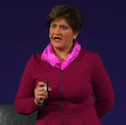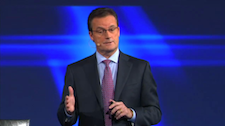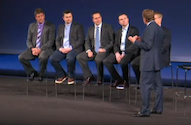Cisco Buys Insieme SDN, Invites Microsoft to ACI PartyCisco Buys Insieme SDN, Invites Microsoft to ACI Party
Cisco Systems has acquired Insieme and Microsoft was a surprise guest at the press conference. Clearly, Cisco and VMware will now compete more fiercely even as they cooperate on converged infrastructure.
November 6, 2013

Cisco Systems (CSCO) has acquired Insieme and CEO John Chambers is announcing application-centric infrastructure (ACI) solutions. Microsoft (MSFT) EVP Satya Nadella was a surprise guest at the announcement — a major statement amid potential Cisco-VMware competition and cooperation. The Cisco news addressed software defined networking (SDN) and goes beyond that to support ACI. What are the implications for Cisco investors, shareholders, partners, customers and rivals? Here’s a live blog tracking the Insieme launch in New York.
First Up: Cisco CEO John Chambers
The usual qualifier: Chambers noted that Cisco is in a quiet period and the press gathering does not involve earnings or revenue forecasts.
“In the last six months — more CIOs, CEOs and CXOs have come through Silicon Valley looking for innovative ideas.”
“It’s not just about storage, compute and networking coming along. It’s about application-centric infrastructure” and innovation.
Chambers pointed to trends like mobile, social, Big Data and the Internet of Things.
Technology changes are coming every four years or faster — when they used to required a decade.
Familiar theme: Chambers is reiterating his usual pitch stating that Cisco catches market transition waves — from routing to switching and more. This time around, it’s about application-centric infrastructure and the Internet of Everything. “We anticipate the transitions, bounce the ideas with partners and customers, then transition in the market with speed.”
Compared traditional SDN models to the failed ATM to the desktop trend of two decades ago. Instead, a new operating model is required.
“Software-based network virtualization lacks scale, visibility and security.”
“Instead, the future open model is an application infrastructure that combines physical and virtual networks together with scale.”
“It’s really about the applications that go on this that will make the difference.”
“It’s about creating an application economy — business and personal applications.”
 Next Up: Soni Jiandani, EVP marketing, Insieme Networks
Next Up: Soni Jiandani, EVP marketing, Insieme Networks

Background not mentioned: Cisco has an investment in Insieme, and Insieme could ultimately be a “spin-in” to Cisco over time. Update: The spin-in happened today. Cisco acquired Insieme.
Today’s announcements are about delivering an agile infrastructure.
The announcement involves an application policy infrastructure controller (ACI), and integrates that with the Nexus 9000 Series and an “industry leading ecosystem” including orchestration, hypervisor, storage and layer 4 through 7 companies.
“We’re not just empowering the cloud customers, but also the enterprise, commerical and service provider customers.”
An application-centric policy model. “That’s what you run your business on.”
The architecture has a “pay as you grow model.”
Yes, APIs allow it to extend beyond networking to storage and compute.
The solution delivers six areas of value: Agility, simplicity, automation and visibility, performance and scale, security and open.
“You can’t do it only in software. You need to combine the power of software and hardware innovation.”
She mentioned hypervisor support in this order: Microsoft, Red Hat and VMware… Ouch. Interesting order, The VAR Guy noticed.
OpenStack and OpenDaylight — two of The VAR Guy’s top 5 open source platforms to watch for 2014 — were mentioned.
“Network automation is finally possible.”
She claimed ACI total cost of ownership would deliver a 75 percent total cost of ownership savings.
A graphic claimed that there’s a software virtual machine tax for a two-part software and hardware SDN network. It apparently was a dig at VMware and software providers that have their own SDN strategies. “There is a virtual machine tax of $10 per virtual machine per month, or over $100 per port per month,” she claimed.
Instead, build one network that’s hardware and software and you reduce total cost of ownership by 75 percent, she claimed.
 Next Up: Microsoft EVP Satya Nadella
Next Up: Microsoft EVP Satya Nadella

Shocker: Microsoft’s Nadella and Chambers are sharing the stage.
Nadella is a rumored candidate to succeed Microsoft CEO Steve Ballmer.
Microsoft and Cisco share the application-centric infrastructure vision, Nadella asserted.
This can’t be a happy moment for VMware, which partners with Cisco on VCE.
 Next Up: Cisco President Rob Lloyd
Next Up: Cisco President Rob Lloyd

Side note: The VAR Guy believes Lloyd is among the candicates to succeed John Chambers as Cisco CEO. Lloyd is one of two Cisco presidents.
Lloyd seems slighyly nervous in front of the New York crowd, which includes financial analysts. Speculation: Is this a test or audition for the CEO post? Hmmm…
Lloyd is speaking about investment protection — allowing Cisco customers to march toward application-centric infrastructure.
Cisco will introduce a flexible licensing model in a few months, Lloyd indicated.
 Next Up: Panel Discussion led by Lloyd
Next Up: Panel Discussion led by Lloyd

Includes: (1) Brad Anderson, VP Windows Server and Systems Center, Microsoft; (2) IBM VP and GM Deepak Advani; (3) Red Hat CEO Jim Whitehurst; (4) EMC EVP Jeremy Burton; (5) Citrix SVP Gordon Payne; (6) Symantec President Francisco Desouza and (7) F5 CEO John McAdams.
The overall panel chatter: Customers need more flexible, agile, scalible application and network infrastructures as users go cloud and mobile. Cisco and the panel assert that ACI with third-party solution integrations solve that.
Quote of the day: ACI is like GPS for applications — helping you to track and manage applications amid the mobile and cloud realities, according to Citrix SVP Gordon Payne.
 Next Up: Customer Panel Led By Chambers
Next Up: Customer Panel Led By Chambers

Includes: (1) Jay Kidd, CTO, NetApp; (2) Octave Klaba, CEO, OHV (a cloud services provider); (3) Tim Beerman, VP hosting business unit, Savvis; Brett Jones, director of infrastructure services, Cerner (a healthcare IT specialist); Mike Capone, VP and CIO, ADP.
Panel takeaways: ACI will allow customers to scale, adjust and accelerate their innovation cycles across applications, cloud services and mobile.
About the Author
You May Also Like


